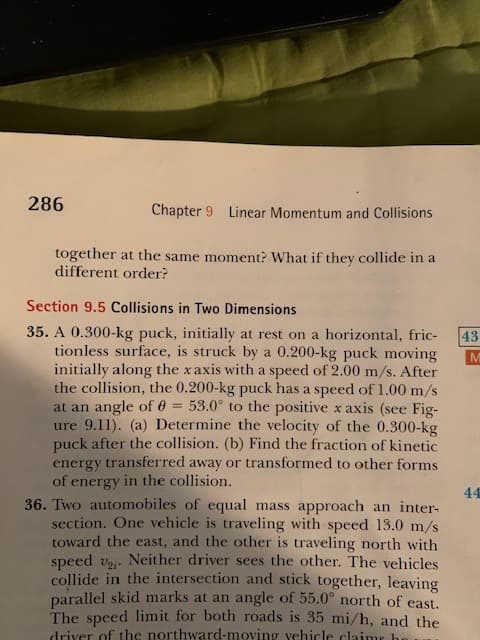35. A 0.300-kg puck, initially at rest on a horizontal, fric- tionless surface, is struck by a 0.200-kg puck moving initially along the xaxis with a speed of 2.00 m/s. After the collision, the 0.200-kg puck has a speed of 1.00 m/s at an angle of 0 = 53.0° to the positive x axis (see Fig- ure 9.11). (a) Determine the velocity of the 0.300-kg puck after the collision. (b) Find the fraction of kinetic energy transferred away or transformed to other forms of energy in the collision.
35. A 0.300-kg puck, initially at rest on a horizontal, fric- tionless surface, is struck by a 0.200-kg puck moving initially along the xaxis with a speed of 2.00 m/s. After the collision, the 0.200-kg puck has a speed of 1.00 m/s at an angle of 0 = 53.0° to the positive x axis (see Fig- ure 9.11). (a) Determine the velocity of the 0.300-kg puck after the collision. (b) Find the fraction of kinetic energy transferred away or transformed to other forms of energy in the collision.
Principles of Physics: A Calculus-Based Text
5th Edition
ISBN:9781133104261
Author:Raymond A. Serway, John W. Jewett
Publisher:Raymond A. Serway, John W. Jewett
Chapter8: Momentum And Collisions
Section: Chapter Questions
Problem 33P
Related questions
Question
please resolve the problem #35 (picture attached). thank you.

Transcribed Image Text:35. A 0.300-kg puck, initially at rest on a horizontal, fric-
tionless surface, is struck by a 0.200-kg puck moving
initially along the xaxis with a speed of 2.00 m/s. After
the collision, the 0.200-kg puck has a speed of 1.00 m/s
at an angle of 0 = 53.0° to the positive x axis (see Fig-
ure 9.11). (a) Determine the velocity of the 0.300-kg
puck after the collision. (b) Find the fraction of kinetic
energy transferred away or transformed to other forms
of energy in the collision.
Expert Solution
Step 1
Given data:
Mass of first puck (m1) = 0.3 kg
Mass of second puck (m2) = 0.2 kg
Initial velocity of the (m2) mass (vi) = 2 m/s
Speed of the mass (m2) after the collision (v1) = 1 m/s at an angle 53 degree.
Need to determine the velocity of the mass (m1) after the collision and energy lost in collision.
Trending now
This is a popular solution!
Step by step
Solved in 2 steps

Knowledge Booster
Learn more about
Need a deep-dive on the concept behind this application? Look no further. Learn more about this topic, physics and related others by exploring similar questions and additional content below.Recommended textbooks for you

Principles of Physics: A Calculus-Based Text
Physics
ISBN:
9781133104261
Author:
Raymond A. Serway, John W. Jewett
Publisher:
Cengage Learning

College Physics
Physics
ISBN:
9781305952300
Author:
Raymond A. Serway, Chris Vuille
Publisher:
Cengage Learning

Physics for Scientists and Engineers: Foundations…
Physics
ISBN:
9781133939146
Author:
Katz, Debora M.
Publisher:
Cengage Learning

Principles of Physics: A Calculus-Based Text
Physics
ISBN:
9781133104261
Author:
Raymond A. Serway, John W. Jewett
Publisher:
Cengage Learning

College Physics
Physics
ISBN:
9781305952300
Author:
Raymond A. Serway, Chris Vuille
Publisher:
Cengage Learning

Physics for Scientists and Engineers: Foundations…
Physics
ISBN:
9781133939146
Author:
Katz, Debora M.
Publisher:
Cengage Learning

University Physics Volume 1
Physics
ISBN:
9781938168277
Author:
William Moebs, Samuel J. Ling, Jeff Sanny
Publisher:
OpenStax - Rice University

College Physics
Physics
ISBN:
9781285737027
Author:
Raymond A. Serway, Chris Vuille
Publisher:
Cengage Learning

Physics for Scientists and Engineers, Technology …
Physics
ISBN:
9781305116399
Author:
Raymond A. Serway, John W. Jewett
Publisher:
Cengage Learning